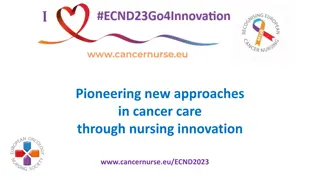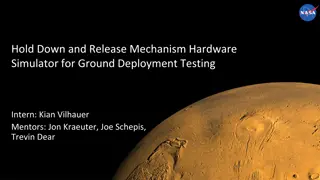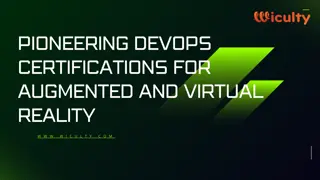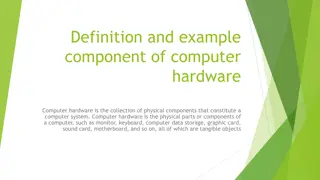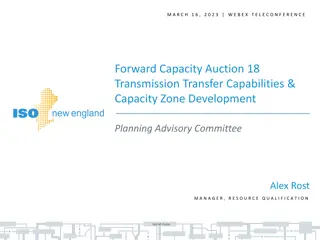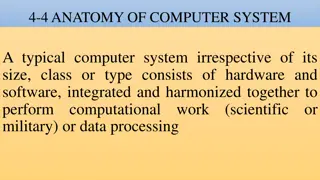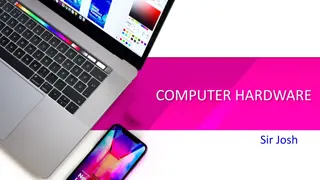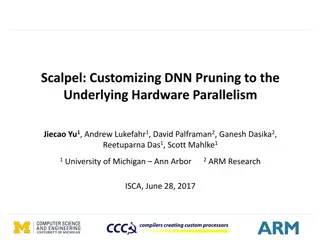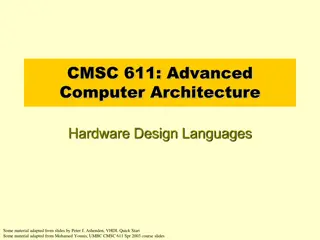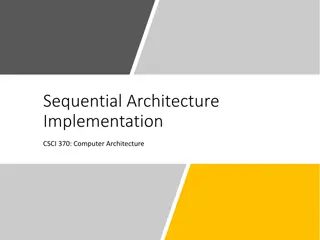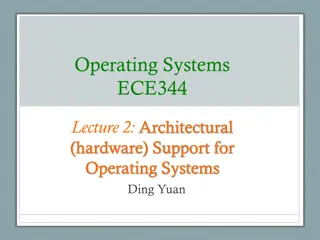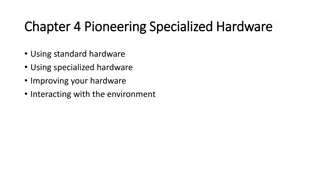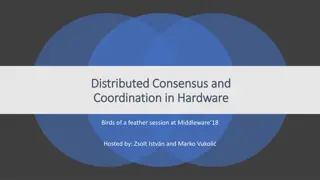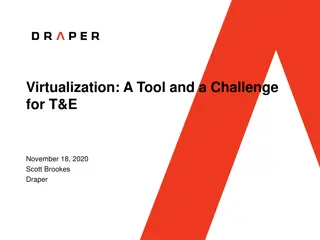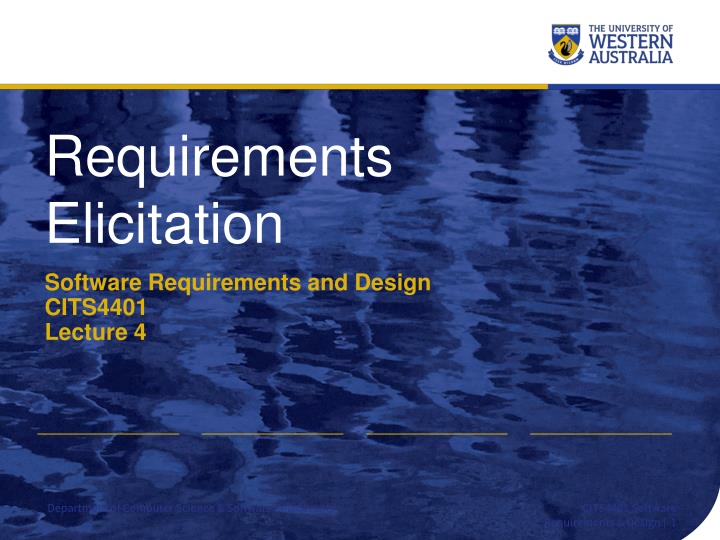
Pioneering Specialized Hardware and Enhancing Capabilities
One key reason for early AI failures was inadequate hardware, but modern advancements in standard and specialized hardware have overcome many challenges. Learn about utilizing standard hardware, enhancing capabilities, relying on GPUs for computational techniques, and more in the world of specialized hardware.
Download Presentation

Please find below an Image/Link to download the presentation.
The content on the website is provided AS IS for your information and personal use only. It may not be sold, licensed, or shared on other websites without obtaining consent from the author. If you encounter any issues during the download, it is possible that the publisher has removed the file from their server.
You are allowed to download the files provided on this website for personal or commercial use, subject to the condition that they are used lawfully. All files are the property of their respective owners.
The content on the website is provided AS IS for your information and personal use only. It may not be sold, licensed, or shared on other websites without obtaining consent from the author.
E N D
Presentation Transcript
Requirements Elicitation Software Requirements and Design CITS4401 Lecture 4 Department of Computer Science & Software Engineering CITS4401 Software Requirements & Design | 1
Lecture Overview What is Requirements Elicitation Requirements Sources Elicitation Techniques Reference: SWEBOK 3.0 Chapter 1 Section 3 Department of Computer Science & Software Engineering CITS4401 Software Requirements & Design | 2
1. What is Reqs Elicitation? Process Essence Communication Scope Department of Computer Science & Software Engineering CITS4401 Software Requirements & Design | 3
The Essence At the core of any requirements process is the ability to get people to tell you what they really need, rather than their perceived solution, or what they think you might be able to deliver. S & J Roberson, Mastering the Requirements Process, volere.org https://www.volere.org/wp-content/uploads/2019/02/howNowBrownCow.pdf https://www.volere.org/the-brown-cow-model/. (7 min video) See Workshop 1 Department of Computer Science & Software Engineering CITS4401 Software Requirements & Design | 4
What is Requirements Elicitation? The process through which the customers, buyers, users, regulators and any others who are stakeholders in the development of a software system discover, reveal, articulate and understand their requirements. Requirements elicitation is concerned with the origins of software requirements and how the software engineer can collect them. Also known as requirements capture, requirements discovery, requirements acquisition and requirement gathering Department of Computer Science & Software Engineering CITS4401 Software Requirements & Design | 5
Requirements vs Specifications Requirements is probably the most misused word in our industry. Required means nonnegotiable, yet in almost every project we see changed, bartered, and negotiated requirements I propose using the word specification instead. Specifications are changeable and are understood as the current state of our understanding. W.Royce, IEEE Software, Sep/Oct 2005 Get a copy from http://ieeexplore.ieee.org/ via UWA Department of Computer Science & Software Engineering CITS4401 Software Requirements & Design | 6
Communication Elicitation is fundamentally a human activity and is where the stakeholders are identified and relationships established between the development team and the custom One of the fundamental principles of a good requirements elicitation process is that of effective communication between the various stakeholders. Requirements specialists mediate between the domain of the software users (and other stakeholders) and the technical world of the software engineer. Department of Computer Science & Software Engineering CITS4401 Software Requirements & Design | 7
Project Scope A critical element of requirements elicitation is informing the project scope. This involves providing a description of the software being specified and its purpose and Prioritizing the deliverables to ensure the customer s most important business needs are satisfied first. Department of Computer Science & Software Engineering CITS4401 Software Requirements & Design | 8
Reqs Elicitation Challenges Articulation Problems Expressing the requirements since we don t know what we don t know Communication Barriers Different languages in different domains Knowledge and Cognitive Limitations Managing complexity Human Behaviour Issues Conflicting needs Technical Issues Change management Too rigid adherence to methodology Department of Computer Science & Software Engineering CITS4401 Software Requirements & Design | 9
2. Requirements Sources Goals Domain knowledge Stakeholders Business Rules Operational Environment Organisational environment Department of Computer Science & Software Engineering CITS4401 Software Requirements & Design | 10
Sources: Goals Goals. The term goal (sometimes called business concern or critical success factor ) refers to the overall, high-level objectives of the software. Goals provide the motivation for the software but are often vaguely formulated. Software engineers need to pay particular attention to assessing the value (relative to priority) and cost of goals. A feasibility study is a relatively low-cost way of doing this. Department of Computer Science & Software Engineering CITS4401 Software Requirements & Design | 11
What is a goal? An objective that the system under consideration should achieve Goals are optative (express a wish) rather than indicative (stating a thing as fact), e.g., serve more passengers acceleration command is delivered on time Notice the different levels of abstraction Department of Computer Science & Software Engineering CITS4401 Software Requirements & Design | 12
Sources: Domain knowledge. The software engineer needs to acquire or have available knowledge about the application domain. Domain knowledge provides the background against which all elicited requirements knowledge must be set in order to understand it. A knowledge domain ontology can be used to capture this knowledge Ontology is a formal, explicit specification of a shared conceptualization (Gruber, 1993). Relations between relevant concepts within the application domain should be identified. See UWA s text to knowledge graph tool (winner of ICDM 19 competition). http://agent.csse.uwa.edu.au/text2kg/ Department of Computer Science & Software Engineering CITS4401 Software Requirements & Design | 13
Sources: Stakeholders Much software has proved unsatisfactory because it has stressed the requirements of one group of stakeholders at the expense of others. Hence, the delivered software is difficult to use, or subverts the cultural or political structures of the customer organization. The software engineer needs to identify, represent, and manage the viewpoints of many different types of stakeholders. Requirements negotiation will be discussed later in the unit Department of Computer Science & Software Engineering CITS4401 Software Requirements & Design | 14
Sources: Business Rules These are statements that define or constrain some aspect of the structure or the behavior of the business itself. A student cannot register in next semester s courses if there remain some unpaid tuition fees would be an example of a business rule for a university s course-registration software. Department of Computer Science & Software Engineering CITS4401 Software Requirements & Design | 15
Sources: operational environment Requirements will be derived from the environment in which the software will be executed. These may be, for example, timing constraints in real-time software or performance constraints in a business environment. These must be sought out actively because they can greatly affect software feasibility and cost as well as restrict design choices. Department of Computer Science & Software Engineering CITS4401 Software Requirements & Design | 16
Src: organizational environment Software is often required to support a business process, the selection of which may be conditioned by the structure, culture, and internal politics of the organization. The software engineer needs to be sensitive to these since, in general, new software should not force unplanned change on the business process. Department of Computer Science & Software Engineering CITS4401 Software Requirements & Design | 17
Approaches & Techniques Asking Interviews Scenarios Prototypes Facilitated meetings Observation User stories And others (the above list is not exhaustive) Observing and Inferring Discussing and Formulating Negotiating with respect to a standard set Studying and Identifying Problems Discovering through creative processes Postulating Department of Computer Science & Software Engineering CITS4401 Software Requirements & Design | 18
3. Methods 1. Interviews 2. Facilitated meetings 3. Prototypes 4. Observation Scenarios User stories Department of Computer Science & Software Engineering CITS4401 Software Requirements & Design | 19
1. Interviews Interviewing stakeholders is a traditional means of eliciting requirements. Important to understand the advantages and limitations of interviews and how they should be conducted. Department of Computer Science & Software Engineering CITS4401 Software Requirements & Design | 20
Interviews An interview is a systematic attempt to collect information from a person. Interviewing success depends on ability to identify: work flows, factors that influence the operations of systems, and the elements (documents, procedures, policies, etc.) that make up systems. Poorly performed interviews may: lead to systems which do not meet the needs of the organization affect the attitudes of the users and have a negative effect on the entire project effort Department of Computer Science & Software Engineering CITS4401 Software Requirements & Design | 21
5 Steps of the Interview Process 1. Preparing for the interview 2. Planning and scheduling the interview 3. Opening and closing the interview 4. Conducting the interview 5. Following up for clarification Department of Computer Science & Software Engineering CITS4401 Software Requirements & Design | 22
Problem: Resistance may be found Department of Computer Science & Software Engineering CITS4401 Software Requirements & Design | 23
Problem: Conflicting requirements Department of Computer Science & Software Engineering CITS4401 Software Requirements & Design | 24
2. Facilitated meetings Purpose: try to achieve a summative effect, whereby a group of people can bring more insight into their software requirements than by working individually. Advantage: Brainstorm and refine ideas that may be difficult to bring to the surface using interviews. Advantage: conflicting requirements surface early on in a way that lets the stakeholders recognize where these occur. Advantages: may result in a richer and more consistent set of requirements than might otherwise be achievable. Disadvantage: meetings need to be handled carefully (hence the need for a facilitator) to avoid poor group dynamics Disadvantage: Meetings are time consuming (hence the need for a facilitator) Department of Computer Science & Software Engineering CITS4401 Software Requirements & Design | 25
Brainstorming A simple group technique for generating ideas Allows people to suggest and explore ideas in an atmosphere free of criticism or judgement Works best with 4 to 10 people 1 person to get the session started, but not constrain it Department of Computer Science & Software Engineering CITS4401 Software Requirements & Design | 26
Brainstorming Generation Phase: participants encouraged to offer as many ideas as possible without discussion of the merits of ideas Consolidation Phase: ideas are discussed, revised and organised Department of Computer Science & Software Engineering CITS4401 Software Requirements & Design | 27
Brainstorming (cont.) Department of Computer Science & Software Engineering CITS4401 Software Requirements & Design | 28
3. Prototypes Valuable tool for clarifying ambiguous requirements. Act in a similar way to scenarios by providing users with a context within which they can better understand what information they need to provide. Wide range of prototyping techniques from paper mockups of screen designs to beta-test versions of software products Protypes can also be used requirements validation (see later) Low fidelity prototypes are often preferred to avoid the stakeholder anchoring on minor, incidental characteristics that could limit design flexibility Disadvantage: Choose implementation too early Risk: Rough prototype becomes the product Department of Computer Science & Software Engineering CITS4401 Software Requirements & Design | 29
Scenarios and Use Cases Scenarios and use cases are commonly used in planned methodologies, especially in the object-oriented UML setting Scenarios provide a valuable means for providing context to the elicitation of user requirements. They allow the software engineer to provide a framework for questions about user tasks by permitting what if and how is this done questions to be asked. The most common type of scenario is the use case description. See week 1 and later Department of Computer Science & Software Engineering CITS4401 Software Requirements & Design | 30
User Stories User stories are commonly used in adaptive or agile methodologies Short, high-level descriptions of required functionality expressed in customer terms. A typical user story has the form: As a <role>, I want <goal/desire> so that <benefit>. Just enough information so that the developers can produce a reasonable estimate of the effort to implement it. The aim is to avoid some of the waste that often happens in projects where detailed requirements are gathered early but become invalid before the work begins. See week 1 Department of Computer Science & Software Engineering CITS4401 Software Requirements & Design | 31
4. Observation / Ethnography Analyst immerses herself in the working environment where the system will be used She observes the day-to-day work and notes the actual tasks in which participants are involved This helps discover implicit system requirements that reflect the actual rather than formal processes in which people are involved Advantage: discovers many user tasks and business processes that are too subtle and complex for their actors to describe easily. Disadvantage: Expensive (analyst works in client environment) Disadvantage: Observer should be detached: end-user based, non- judgemental so not appropriate for discovering organisational or domain requirements Department of Computer Science & Software Engineering CITS4401 Software Requirements & Design | 32
Pulling this all Together Some Guidelines Department of Computer Science & Software Engineering CITS4401 Software Requirements & Design | 33
A Generic Requirements Process ELICITATION Identify relevant sources of requirements Ask appropriate questions to gain an understanding of their needs AND THEN Analyse the gathered information, looking for implications, inconsistencies or unresolved issues Confirm your understanding of the requirements with the users (validate) Synthesize appropriate statements of the requirements (specify) Department of Computer Science & Software Engineering CITS4401 Software Requirements & Design | 34
Systems Thinking 1. What objectives are we trying to achieve? 2. What decisions do we control which affect those objectives? 3. What items dictate constraints on our range of choices? 4. What criteria should we use to evaluate candidate solutions? 5. What decision provides with the most satisfactory outcome with respect to those criteria? Department of Computer Science & Software Engineering CITS4401 Software Requirements & Design | 35
Sommerville & Sawyer Elicitation Guidelines 1. Assess system feasibility 2. Be sensitive to organisational and political considerations 3. Identify and consult system stakeholders 4. Record Requirements Sources 5. Define the system s operating environment 6. Use business concerns to drive requirements elicitation Department of Computer Science & Software Engineering CITS4401 Software Requirements & Design | 36
Elicitation Guidelines (cont) 7. Look for domain constraints 8. Record requirements rationale 9. Collect requirements from multiple viewpoints 10. Prototype poorly understood requirements 11. Use scenarios to elicit requirements 12. Define operational processes 13. Reuse requirements Department of Computer Science & Software Engineering CITS4401 Software Requirements & Design | 37
Lecture Summary What is Requirements Elicitation? Process; Essence; Communication; Scope Requirements Sources Elicitation Techniques Interviews; Facilitated meetings; Prototypes; Scenarios; User Stories see next week Department of Computer Science & Software Engineering CITS4401 Software Requirements & Design | 38
Recommended reading SWEBOK 3.0 Chapter 1 Section 3 R. S. Pressman, Software Engineering: A Practitioner s Approach, 9thed., 2020 Chapter 7 Understanding Requirements B. Bruegge and A. H. Dutoit, Object-Oriented Software Engineering Using UML, Patterns, and Java, 3rded., Prentice Hall, 2010 Section 4.3.1 Software Specification Section 7.2 Requirements Elicitation and Analysis Department of Computer Science & Software Engineering CITS4401 Software Requirements & Design | 39


